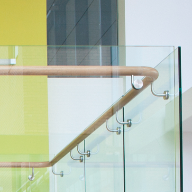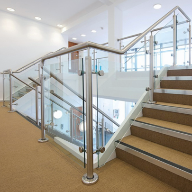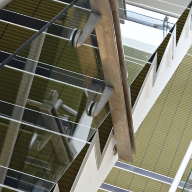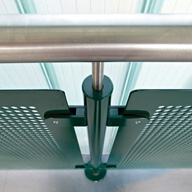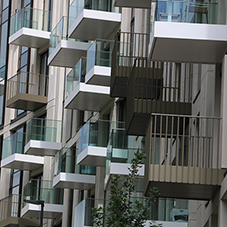A blog written by Sapphire Balconies…
The impact of accumulated carbon emissions is driving climate change and biodiversity collapse, the construction industry has a significant role to play in addressing these serious issues for our planet.
At Sapphire, we believe architects, designers and constructers can make a real difference by looking beyond the green rating tools and taking a more holistic approach to designing healthy, climate-friendly buildings that support biodiversity.
Defining net zero
Traditionally, net zero carbon was largely understood to apply to a building’s operational energy use. Today, a fuller definition of net zero must include embodied emissions across the supply chain, from materials and construction methods through to the ‘hidden’ carbon effects of site labour and product delivery.
Carbon in construction can be broken down into embodied carbon and occupational carbon. The first applies to how much carbon is going to be emitted through the creation and end of life of a building. Occupational carbon relates to a building’s thermal performance and potential heat loss. In addition, the operational carbon includes the emissions of companies in the supply chain.
Material choices
Most materials have embodied carbon which comes from the energy consumed to produce, process, and transport the material. Different materials have different levels of embodied carbon, so the choice of material for, say, a residential balcony can have an impact on a building’s overall carbon footprint.
One of the first steps to tackling embodied carbon, therefore, is to assess material options and understand how their embodied carbon compares. When specifying balconies, the most common materials used are concrete, steel and aluminium.
In calculations compiled by Sapphire, the embodied carbon of aluminium is estimated at 2.44 tonnes per balcony (0.41 tonnes per m2) compared with 3.79 (0.63) for steel and 4.23 (0.71) for concrete.
These figures are calculated on embodied carbon from the mining and shipping of the raw material, as well as travel of workers and site delivery. Weight is a key factor in these calculations as reduced weight equals reduced emissions. This is clearly shown by the fact that the embodied carbon in shipping aluminium at 0.06 per tonne is significantly lower than steel at 0.21 and concrete at 0.34 per tonne.
Dramatic savings
When assessing materials, it is equally important to consider the reduction in embodied carbon when including thermal breaks. Unbroken concrete balconies are estimated to emit 45.4 tonnes of CO2 over 60 years compared with 5.1 tonnes for thermally broken aluminium over the same period.
This means a massive 89% reduction in CO2 could be made by specifying aluminium, while the annual CO2 saving on a typical 250 balcony scheme using this option would be 278 tonnes.
This dramatic saving is one of the many reasons that Sapphire is at the forefront of innovative modular balcony solutions that combine the benefits of offsite manufacturing with aluminium frames as a strong, yet lightweight alternative to steel. Apart from making informed material choices, we recommend specifiers consider how offsite products and innovations that reduce labour and deliveries, for example, can have a positive effect on reducing embodied carbon.
Offsetting
Although the choice of construction materials and methods can reduce the embodied carbon of a building, it may not be enough to cut it out completely. When this is the case specifiers can offset some of the carbon with credits.
Offsetting is sometimes viewed as an easier option to incorporating carbon-neutral product. However, if the UK is to meet its climate goals, we believe that carbon reduction should always be the first priority before resorting to offsetting.
Evidence
When making product choices it is essential for architects and designers to have confidence in the claims made by the supply chain. But what evidence should you be looking for? Suppliers must be able to demonstrate the measures they take to reduce emissions from their own operations, whether that’s making the transition to electric/hybrid vehicles, investing in energy efficient equipment or renewable power.
Additionally, check for specific accreditations that recognise sustainable performance like ISO 14001 which Sapphire has maintained since 2009.
Innovation
With the UK Government’s pledge to reduce the energy consumption of buildings by half by 2030, clever innovations from forward-thinking companies like Sapphire will be at the forefront in meeting this target.
Being approximately half the weight of steel, our offsite manufactured aluminium balconies are far more efficient to transport and install. This not only cuts emissions during transport but also means our balconies need fewer brackets to secure them in place. Fewer brackets and connections between the balcony and the buildings reduce the risk of cold bridging and damp, making the building more energy efficient and reducing occupational carbon emissions.
We are also proud to say that our balconies are almost entirely recyclable – another important consideration for architects looking to achieve increasingly stringent carbon reduction and sustainability targets.
To find out more please visit Sapphire’s Sustainability Hub.
Join Sapphire at the upcoming Resibuild event, Construction’s Carbon Dilemma: Why, When & How? On 26th May, you sign up here.
View Glide-On™ Cassette® Balconies Product Entry

![The Construction Carbon Dilemma [BLOG]](/2020-08-11_20.11.31_l813tj-file115419.jpg)
![The Construction Carbon Dilemma [BLOG]](/Green_Park_Phase_6_Sunset_7_hfaqlc-file115421.jpg)
![The Construction Carbon Dilemma [BLOG]](/IMG_3657_uyaxi3-file115423.jpg)
![The Construction Carbon Dilemma [BLOG]](/IMG_5391_cnuzgp-file115425.jpg)
![The Construction Carbon Dilemma [BLOG]](/IMG_6071_t4mggn-file115426.jpg)
![The Construction Carbon Dilemma [BLOG]](/IMG_8218_vyttjc-file115427.jpg)
![The Construction Carbon Dilemma [BLOG]](/IMG_8421_qdpmjg-file115429.jpg)

